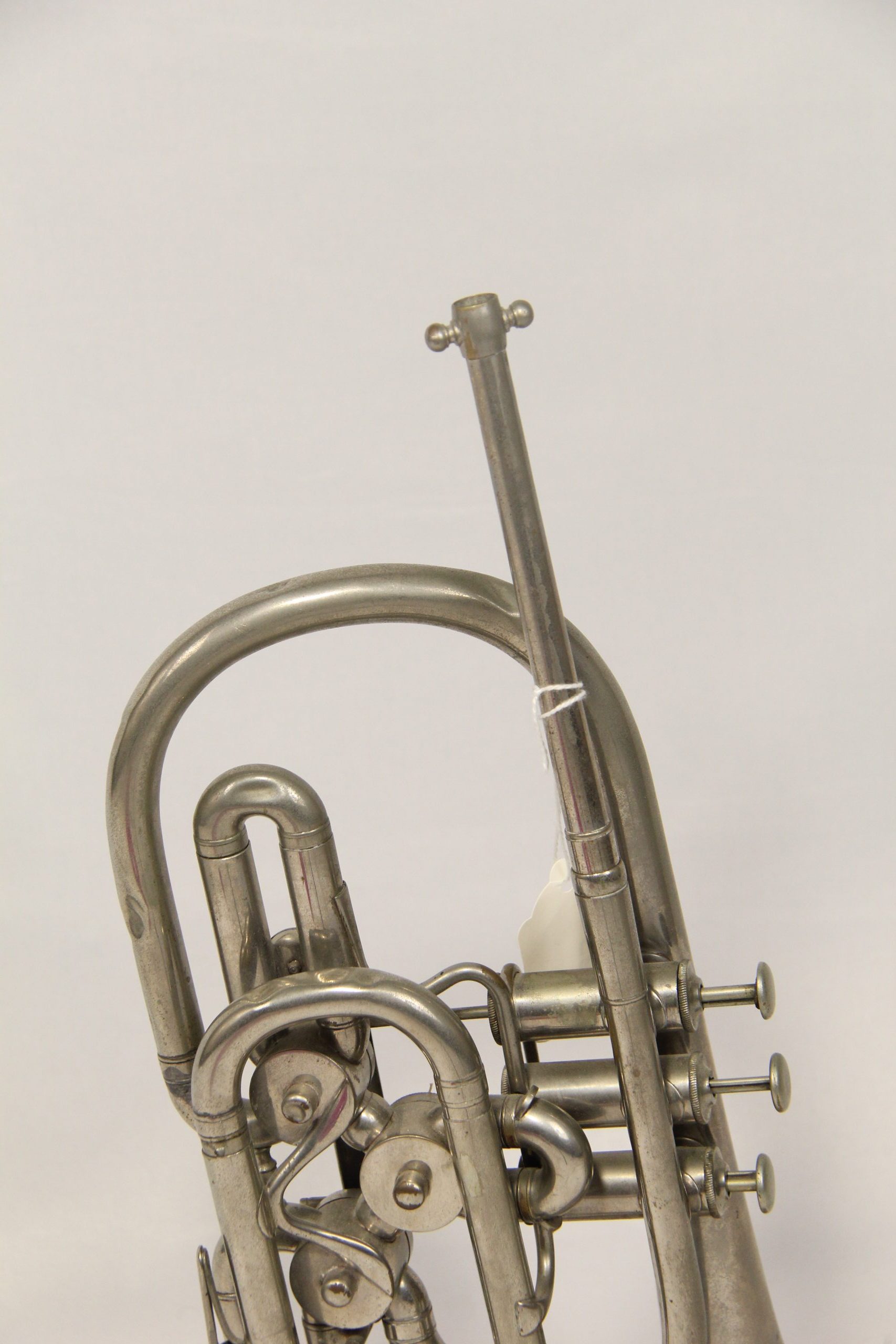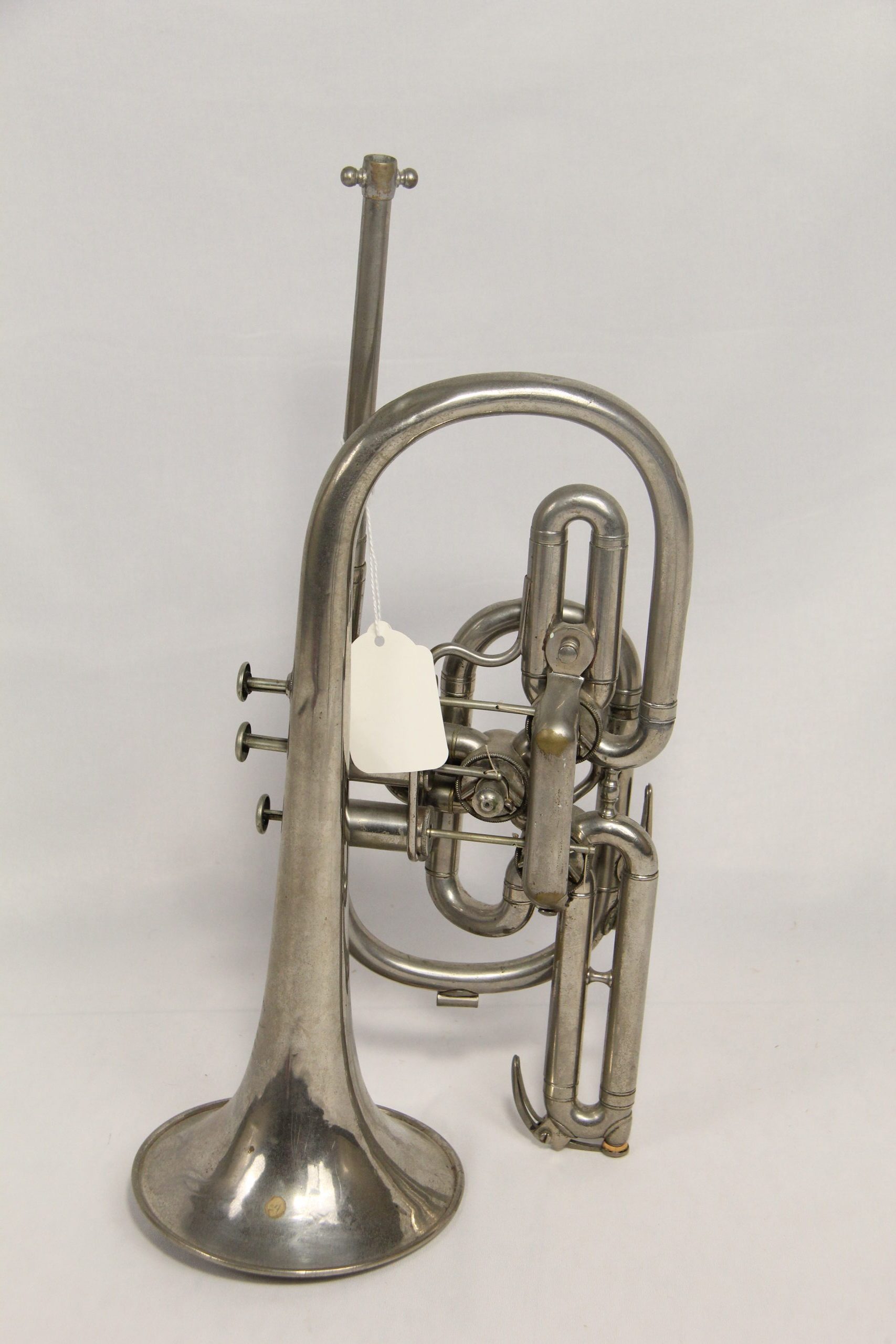Circular Signal Bugle
This is a canal boat signalhorn. This bugle itself is a tiny bugle with a surprising amount of sound. The bugle is one of the simplest brass instruments, normally having no valves or other pitch-altering devices. All pitch control is done by varying the player’s embouchure. Bugles differ from cornet mainly in having wider bores. Natural bugles are perhaps too readily thought of nowadays as military instruments, but in the 19th century, the key bugle was an important band and solo instrument.

The bugle developed from early musical or communication instruments made of animal horns, with the word ‘bugle’ itself deriving from ‘buculus’ Latin for bullock (castrated bull). The first bugles were shaped in a coil, typically double coil, but also a single or triple coil – similar to the modern horn, and were used to communicate during hunts and as announcing instruments for coaches (somewhat akin to today’s automobile horn). Predecessors and relatives of the bugle included the post horn, the Pless horn (sometimes called the “Prince Pless horn”), the bugle horn, and the shofar, among others. [1] The ancient Roman army used the buccina.
The first documented formal use of a brass bugle as a military signal device was the Halbmondbläser, or half-moon bugle, used in Hanover in 1758. It was crescent-shaped (hence its name) and comfortably carried by a shoulder strap attached at the mouthpiece and bell. It first spread to England in 1764 where it was gradually accepted widely in foot regiments.

18th-century cavalry did not normally use a standard bugle, but rather an early trumpet that might be mistaken for a bugle today, as it lacked keys or valves, but had a more gradual taper and a smaller bell, producing a sound more easily audible at close range but with less carrying power over distance.
Bugles are primarily used in the military, to indicate daily routines of camp, by cavalry to relay instructions, or to assemble leaders. In most military units, the bugle is sometimes fitted with a small banner or gold fringed tabard with arms of its reporting service branch. Taps or Last Post is a traditional military bugle call to signify the end of a day, or at a military funeral to indicate a soldier going to his final rest.

Klemm and Brothers were importers, manufacturers, and wholesale dealers of musical instruments. Their first shop was established in 1819 in Philadelphia by John George Klemm, selling instruments made in Germany by the Klemm family.
In 1825, they opened a piano factory and by 1838 were also making bugles. The Klemm Brothers supplied CF Martin with machine heads and strings in the 1860s and also sold Martin’s guitars. Fredrick’s sons John and Edward joined the family firm but by 1900 their instrument import & distribution business appears to have closed.
Sources
- The Light Infantry. “History of the Bugle Horn.” History of the bugle horn. Accessed June 16, 2022. https://web.archive.org/web/20071005210959/http://www.army.mod.uk/lightinfantry/history_traditions/dress_drill_customs_traditions/regimental_dress/the_bugle_horn.htm.
- Dictionary.com. “Bugle Definition & Meaning.” Dictionary.com. Dictionary.com. Accessed June 16, 2022. https://www.dictionary.com/browse/bugle.
- “The Last Post.” The Last Post | Army.gov.au. Accessed June 16, 2022. https://www.army.gov.au/our-heritage/traditions/last-post.
- Fotomen, Jr. By 刘快快, 刘快快, By显赫, 显赫, * 名字, By巴斯光年, and 巴斯光年. “纪念沙飞.” FOTOMEN. Accessed June 16, 2022. https://fotomen.cn/2005/08/05/ji-nian-sha-fei/.
- Area Handbook for Ethiopia. United States, U.S. Government Printing Office, 1964.
- “Klemm & Brother.” Klemm acoustic guitars. Accessed June 16, 2022. https://www.guitar-list.com/brands/klemm.





